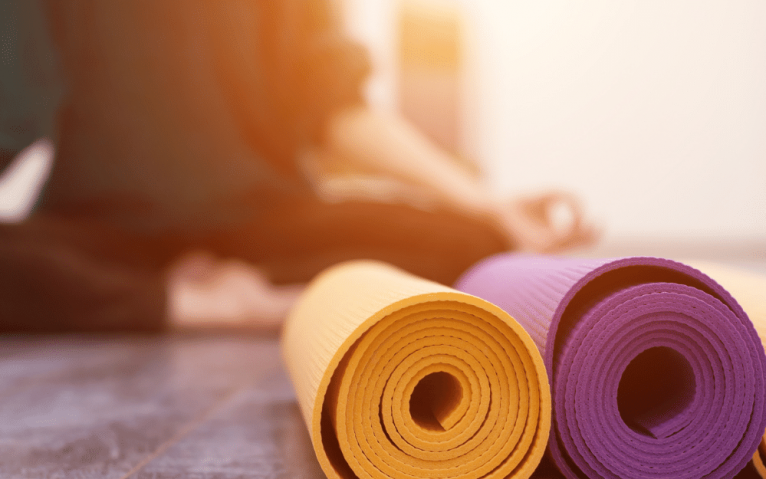As we learn more about the importance of holistic wellness to treat addiction disorders, we begin to incorporate new treatment options. While yoga isn’t meant to be the only treatment to address addiction, researchers believe incorporating the practice into a comprehensive approach can help. Today, many rehab centers include yoga classes in both their inpatient and outpatient treatment programs. So, if you or someone you know needs some help with their journey after treatment, try this sequence of eight yoga poses for addiction recovery.
The Science Behind Yoga for Addiction Recovery
With relapse rates higher than 40 percent, addiction specialists and those in recovery are turning to adjunct therapies such as yoga. The goal is to give addicts the skills they need to learn to tolerate the uncomfortable feelings and sensations that can lead to relapses.
Research says yoga is highly effective at regulating stress hormones, including cortisol and adrenaline. These imbalances can lead to anxiety disorders, depressions, PTSD, and substance abuse. If yoga can help people maintain these hormone levels at bay, there’s a chance they won’t feel the need to resort to substances to cope with these feelings.
A small 2007 pilot study published in the Journal of Alternative and Complementary Medicine found that yoga could change brain chemistry. Those in the survey that practiced yoga showed higher neurotransmitter GABA levels, while the other group experienced no change. Low levels of GABA are associated with anxiety and depression; conditions often considered to underlie addiction.
But, we know that addiction recovery isn’t about completing a treatment program. It’s about staying sober. Incorporating yoga into someone’s recovery journey could potentially help prevent relapse and help them cope better with stressful or triggering situations overall.
Yoga Sequence to Practice in Addiction Recovery
If you’re ready to give yoga a try, this peaceful sequence is meant to help you decompress, reduce your stress levels, and balance your mind. There’s no right or wrong way to try this yoga sequence. Some people prefer to do it first thing. Others do it by the end of the day. The one thing that matters is that you do your best to incorporate this routine at least once or twice a week and build up to do it three times a week.
1. Sitting Mountain
Benefits: This pose opens the heart and invites stillness into the body to help you quiet the mind.
Affirmation: A wonderful affirmation to try with this pose is “serenity comes when I surrender.”
How to do it: Start by kneeling with your knees pointed forwards, and your feet stretched behind you. Sit back on your heels so that your back is upright. If this hurts, you can put a small pillow under your buttocks or knees. Relax the shoulders. Breathe deeply and slowly. If you feel your mind wandering off, it helps to repeat the affirmation over and over. Stay in this pose for 10 breaths.
2. Child’s Pose
Benefits: Releases tension in the shoulders and helps relieve mental fatigue. Encourages feelings of protection, and it’s meant to resemble the healing energy we felt in our mother’s womb.
Affirmation: To channel the right energy, repeat, “I rest in trust and patience.”
How to do it: From the previous pose, gently open the knees to the side and lower your head to the floor. Place your hands next to your feet, palms up. Feel your neck and shoulders melt to the ground. Hold this position for at least 5 minutes or as long as you feel needed.
3. Seated Forward Bend
Benefits: Helps stretch the hamstrings and lower back while also fostering calmness and a sense of letting go.
Affirmation: This pose is about encouraging patience, so its affirmation is “I move forward with patience.”
How to do it: From child’s pose, come to a seated position with your legs extended in front of you. Keep your feet flexed, take a deep inhale, and lift your arms above your head. As you exhale, bend at the hips and start lowering your chest toward your knees. Don’t worry about reaching down. Place your hands on your calves, ankles, or feet, wherever you can comfortably reach. The goal is to feel a stretch in the hamstrings and lower back. Hold this pose for 10 breaths.
4. Butterfly
Benefits: This pose gently opens the pelvis and releases tension in our hips.
Affirmation: Think of words that set you free, like “my spirit is as gentle as a butterfly.”
How to do it: From the previous pose, sit up straight. Then, bring the bottoms of your feet together and start pulling them in toward your groin. Your knees should resemble a butterfly’s wings, out to the sides. Inhale deeply, and as you exhale, lean forward, aiming to place your head on the floor. However, you want to keep your spine straight, so go as far as you feel comfortable. Stay there for 10 breaths.
5. Legs Up the Wall
Benefits: Great to relax the legs and feet and to relieve pressure in the lower back.
Affirmation: This pose is about relaxation, “as I relax, I gain insight, clarity, and ease.”
How to do it: From butterfly pose, move closer to a wall. Lie down and slide both legs up the wall. Your buttocks should be pressing against the wall. Let your arms relax on your belly or by your sides. You can always place a pillow under your head or lower back for better support. Hold this pose for at least 10 breaths or for as long as you need.
6. Little Boat Hugging Knees
Benefits: This is an intense healing pose that releases the lower back.
Affirmation: As we heal, we need to trust our progress, so try, “I hold myself with compassion.”
How to do it: From the precious pose, bring your knees toward your chest. Wrap your arms around your knees, and hug them toward you. Keep your chin slightly tucked and your neck long. Hold this position for at least 10 breaths. Feel free to rock from side to side if you want.
7. Knee-Hug Spinal Twist
Benefits: This pose increases the flexibility of your core, but it also releases the lower back.
Affirmation: This pose is all about perspective, “everywhere I turn, I see beauty all around.”
How to do it: After hugging your knees, release the arms to the sides. Keep your knees bent into your chest. Place your palms facing down if you feel you want to receive energy from the earth or facing up if you’re going to release energy. Inhale deeply, as you exhale, move your hips and knees to the left as you turn your head to the right. Hold this position for 5 breaths. Slowly, go back to the center and twist to the other side, hold for 5 more breaths. Repeat if needed.
8. Corpse Pose
Benefits: The most restorative pose in yoga helps relieve the body of any tension and replenishes the mind and body.
Affirmation: To prevent your mind from wandering off, repeat, “I allow myself to relax completely and surrender my mind, body, and spirit.”
How to do it: From your previous pose, extend the legs in front of you, opening them to the sides. Close your eyes, place your arms alongside your body, palms facing up. Relax your jaw by keeping your teeth slightly parted. You can also place one hand on your belly and the other one over your heart. Keep taking deep breaths, and visualize healing energy reaching any spot of your body that feels tense. Relax your body, let go of any worries, feel present in the moment, and let go. Stay in this position for 5 to 20 minutes.









